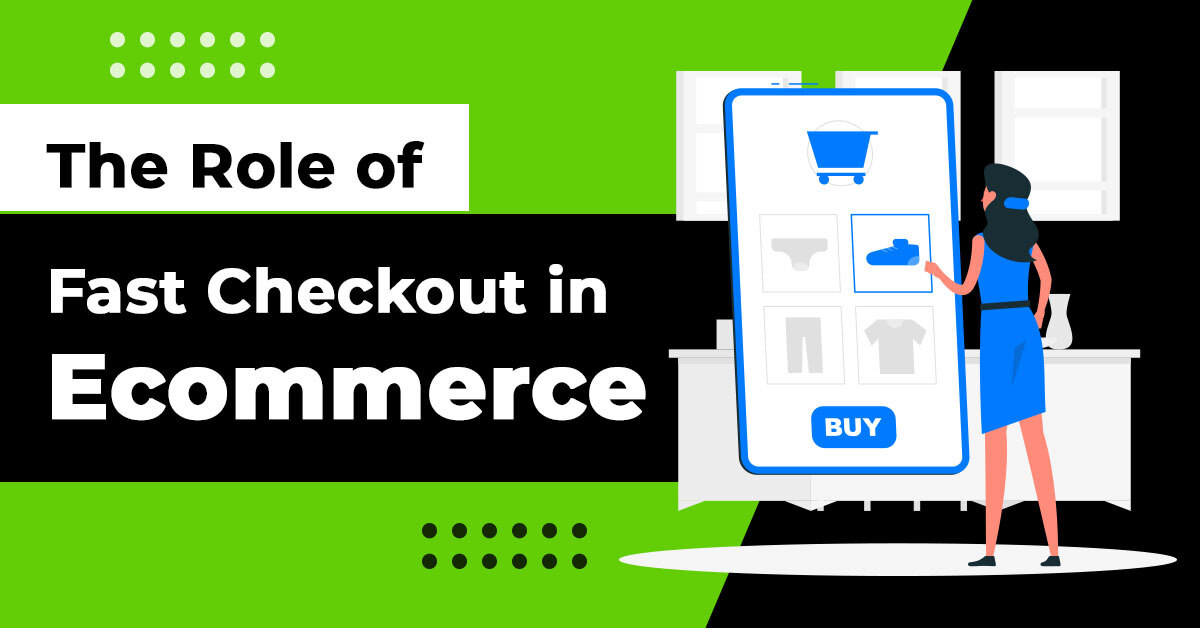In ecommerce, every click counts, and the path to purchase is a journey filled with opportunities and pitfalls. The way customers navigate from product discovery to payment completion is the essence of ecommerce success, and optimizing this journey can make all the difference.
One critical aspect of this journey that has garnered increasing attention is the checkout process. Its role in streamlining the path to purchase cannot be overstated. In this article, we will delve into the world of fast checkout and explore how it can revolutionize the user experience and drive ecommerce conversions.
Furthermore, we will see how ecommerce vendors can harness some key tools to create a seamless and efficient checkout process. So, without further ado, let’s get started:
The Ecommerce Checkout Conundrum
Imagine this: a potential customer visits your ecommerce website, browses through your products, finds the perfect item, adds it to their cart, and proceeds to check out. But as they reach the checkout page, they encounter a series of hurdles: mandatory account creation, a lengthy and confusing form, and the need to input their payment details manually.
Frustrated by the complexity and time-consuming nature of the process, they abandon their cart and leave your website. According to Baymard’s study, the average documented online shopping cart abandonment rate is 70%. The most common reasons for this are mandatory account creation, too long and complex checkout, not enough payment information, and so on.

The checkout process, which should be the final and most straightforward step, often becomes a bottleneck. Customers expect a seamless and hassle-free checkout experience, and failing to deliver on this expectation can result in missed opportunities and revenue.
Understanding the Consumer Journey
A consumer journey can roughly be divided into three phases as explained below:
Exploration Phase
Navigating an ecommerce website should be intuitive and user-friendly. Websites that prioritize ease of use during the exploration phase enhance the overall user experience.
Clear product visibility and well-defined categorization contribute to a smooth exploration of your website. Users should be able to quickly find what they are looking for, facilitating a positive start to their journey.
Decision-Making Phase
Detailed product information and customer reviews play a vital role in the decision-making phase. Users rely on this information to make informed choices, and ecommerce platforms should ensure the information’s accuracy and accessibility.
Personalized recommendations based on user preferences and behavior contribute to a more tailored shopping experience. This increases the likelihood that users can find products that align with their interests.
Purchase Phase
The last conventional checkout process often involves multiple form fields, leading to increased friction and potential cart abandonment. Recognizing these challenges is crucial to understanding the need for faster checkout solutions that aim to address the shortcomings of traditional checkouts.
By minimizing the amount of steps and simplifying the process, these solutions enhance the speed at which users can complete their purchases.

Why Fast Checkout in Ecommerce Is Needed
Fast checkout solutions are required for the following reasons:
Changing Consumer Expectations
With the increasing prevalence of mobile devices, consumers expect the ability to shop on the go. Fast checkout solutions cater to this trend, allowing users to complete transactions quickly, irrespective of their location.
Today, digital consumers have little tolerance for delays, and fast checkout aligns with this mindset, catering to the impatience of modern consumers.
Conversion Rate Optimization
Studies consistently show a direct correlation between checkout speed and conversion rates. The faster the checkout process, the higher the likelihood of users completing their purchases.
Examining real-world case studies provides tangible evidence of the impact of fast checkout on sales and conversion rates. Successful implementations serve as benchmarks for other ecommerce platforms.
Benefits of Fast Checkout
Fast checkout, also known as one-click or one-tap checkout, addresses the pain points of traditional checkout processes. This is a streamlined approach that allows customers to complete their purchases with minimal friction. The benefits of this process include:
- Reduced Friction: Fast checkout eliminates many of the hurdles that often deter customers from completing their purchases. It minimizes the number of steps required, reducing the risk of cart abandonment.
- Improved Conversions: A smooth and efficient checkout process can significantly increase conversion rates. Customers are more likely to complete their purchases when the process is quick and straightforward.
- Enhanced User Experience: Fast checkout contributes to an overall positive user experience. It demonstrates that the ecommerce platform values customers’ time and strives to make their shopping journey as convenient as possible.
- Customer Retention: Providing a fast checkout option can encourage repeat business. Customers who have a positive experience are more likely to return for future purchases.
- Competitive Advantage: Ecommerce is highly competitive. Offering fast checkout can set your business apart from competitors and attract customers seeking a hassle-free shopping experience.
Key Features of Fast Checkout Solutions
Some key features of fast checkout solutions include:
- Seamless Integration with User Accounts: Fast checkout solutions often integrate seamlessly with user accounts, allowing for a more personalized and expedited process. This feature streamlines transactions for returning customers who have saved payment and shipping information.
- One-Click and Express Checkout Options: The introduction of one-click and express checkout options eliminates unnecessary steps in the traditional checkout process. Users can complete transactions with a single click or through an accelerated process, reducing the time and effort required.
- Mobile Optimization for Quick Purchases: Given the prevalence of mobile shopping, fast checkout solutions prioritize mobile optimization. This ensures that users on smartphones and tablets can easily and quickly finalize their purchases, contributing to a positive mobile shopping experience.
- Security Measures to Instill Trust in Users: While speed is crucial, ensuring the security of transactions is paramount. Fast checkout solutions incorporate robust security measures to instill trust in users, addressing concerns related to online payment safety.

Integrating Fast Checkout in Ecommerce
To implement fast checkout, businesses often turn to effective tools that are designed to streamline the checkout process. Here’s how you can make your ecommerce checkout process fast:
Implement One-Tap Login
The journey towards a fast checkout begins with an efficient login process. Traditional account creation and login procedures can be time-consuming and frustrating for customers. One-tap login simplifies this process by allowing users to log in with a single click or tap, often using their social media, Google, or Apple accounts.
Key benefits of this include:
- Offers convenience.
- Reduces cart abandonment.
- Enhanced security.
- Data collection.
- Seamless integration.
Offering Guest Checkout
Allowing customers to make purchases without requiring them to create an account is a proven strategy for speeding up the checkout process. Guest checkout simplifies the steps, as customers only need to provide essential information, such as shipping and payment details, without the added friction of account creation.
Key benefits of this include:
- Quick and hassle-free shopping.
- Reduces cart abandonment rates.
- Effective for first-time shoppers.
Address Autocomplete
Implementing address autocomplete tools can significantly accelerate the checkout process. These tools use predictive search and autofill functionality to help customers quickly complete their shipping addresses. When a customer starts typing their address, the tool provides suggestions and can automatically fill in the remaining fields.
Key benefits of this include:
- Reduces errors in shipping information.
- Saves time for customers.
- Ensures accurate deliveries.
- Overall, it improves the checkout process.
Saved Payment Methods
Offering customers the option to save their payment methods for future use can expedite future purchases. By securely storing credit card information or enabling digital wallet payments like Apple Pay or Google Pay, customers can skip the step of entering payment details for subsequent transactions. Consider hiring a web developer to streamline payment processing seamlessly on your ecommerce website, ensuring a hassle-free and efficient checkout experience for your customers.
Key benefits of this include:
- Seamless and faster checkout experience.
- Offers convenience.
- Improves repeat purchase rate.
Overcoming Challenges in Fast Checkout Implementation
Fast checkout in ecommerce comes with several challenges. Let’s see what they are and how to address them:
- Addressing Security Concerns: Security remains a top concern for users engaging in online transactions. Ecommerce platforms must prioritize robust security measures, including encryption and secure authentication, to address and alleviate user security concerns.
- Dealing With Compatibility Issues: Ensuring compatibility across different devices and browsers can be challenging. However, proactive testing and collaboration with technology partners can help identify and resolve compatibility issues, ensuring a seamless experience for all users.
- Educating Users On the Benefits of Fast Checkout: User education is crucial, especially when introducing new features like fast checkout. Clearly communicating the benefits, such as time savings and convenience, can encourage users to adopt and appreciate the enhanced checkout process.
Future Trends in Fast Checkout
Let’s see what the future of fast checkout in ecommerce looks like:
- Integration of Emerging Technologies: The future of fast checkout lies in the integration of emerging technologies. Biometrics and artificial intelligence (AI) are poised to play a significant role in further streamlining the checkout process and providing innovative solutions for users.
- The Role of Voice-Activated and IoT Devices: As voice-activated and Internet of Things (IoT) devices become more prevalent, ecommerce platforms should explore ways to leverage these technologies for quick and efficient transactions. Voice-activated commands and IoT-enabled transactions could redefine the fast checkout experience.
Offer a Seamless Checkout Experience
In the fiercely competitive landscape of ecommerce, creating a seamless and efficient checkout experience can be a game-changer. Fast checkout, facilitated by one-tap login and other tools is a powerful way to drive conversions, reduce cart abandonment rates, and foster customer loyalty.In the quest for ecommerce success, businesses must prioritize the optimization of the path to purchase. A proven ppc marketing agency can help you get people to your store. It’s your job to simplify the checkout process, thereby helping your ecommerce platform create an environment where customers are more likely to complete their purchases and return for future transactions.










